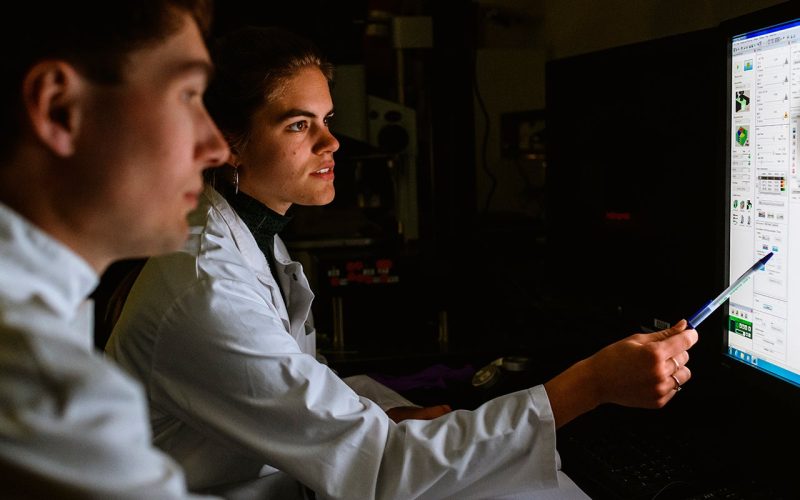Four researchers at UMC Utrecht will receive a Vidi grant of up to 800,000 euros. This was announced by the Netherlands Organization for Scientific Research (NWO). A total of 97 prominent researchers will receive a Vidi.
With the Vidi, the researchers can develop their own innovative line of research and set up or expand a research group over the next five years. These are the following researchers and projects:
Alex Bhogal, assistant professor, high field MRI group
A stroke can have a devastating impact on a person’s life and participation in society. Each year, about 16,000 of the 40,000 stroke patients in the Netherlands (40%) require a lot of rehabilitation. The outcome is not always good: on average, only about 70 percent of what was lost comes back. We don’t yet fully understand why that is, nor do we currently have a way to “fix” the brain. What we do know is that the brains of people who recover well after a stroke show a lot of “plasticity. Their brains have the amazing ability to reorganize networks in response to injury. Why some people have more plastic brains than others is unknown, but that is what Alex Bhogal wants to explore in this project using advanced imaging techniques (7 tesla MRI). His ultimate goal is to better help people with stroke recover. “This project gives me the opportunity to pursue my passion for understanding how the brain works,” Alex said. “The innovations of the Utrecht High Field MRI research group, and the existing research on post-stroke recovery at UMC Utrecht, will be very useful to me in this regard.”
Karin Jongsma, associate professor, Julius Center
In medicine, physicians are increasingly working with artificial intelligence (AI). The relationship between physician and KI is thereby described as a form of collaboration. However, we do not yet fully understand what is meant by this: is it like a collaboration between a boss and his employee, between a police officer and police dog or like between two equals? This project explores how we should understand this collaboration and under what ethical conditions collaboration between physician and KI can be valuable for medical decision-making. “That KI and digitization not only offer great opportunities but also require careful guidance from ethicists, among others, is clear to most people by now,” Karin said. “Especially in a context like medicine, that guidance is indispensable. I am therefore very happy that with the award of this Vidi I can contribute to better understanding and ethically guiding KI in healthcare. In doing so, we will specifically explore how doctors and AI work together, how we should understand that collaboration and its implications for medical decision-making.”
Riccardo Levato, associate professor, Regenerative Medicine Center Utrecht
3D bioprinting, which uses cells to recreate human tissues, could revolutionize medicine. So far, a bioprint is the end of the process. But for cells, it only begins then: they still have to mature into a real tissue after being printed. Riccardo Levato, who is starting this project “TIMESTAMP” from the veterinary faculty of Utrecht University, will develop a new generation of bioprinters that allow cells to continue to develop and grow even after printing until they are the functional tissues we need. “Printing living cells is only the first step toward making human tissues from the lab. I am going to develop technology that can assist and guide cell development to allow tissues to develop even after printing. In fact, I am adding the dimension of time to bioprinting.” To achieve this, Riccardo combines artificial intelligence, intelligent biomaterials and developmental biology.
Maeike Zijlmans, professor of Advanced Neurophysiology in Epilepsy Surgery
1 in 100 people have epilepsy. Focal epilepsy, meaning from one spot in the brain, can be cured with epilepsy surgery, saving people a lifetime of illness. To do this, the neurosurgeon must know as precisely as possible where the epilepsy comes from. This can be done, according to Maeike Zijlmans, by measuring the electrical brain signal during brain surgery directly from the cerebral cortex with special electrode mats and studying the signals with artificial intelligence, among other things. “My team is going to make sure we start recognizing and using the electrical signature of epilepsy to make cures possible more often,” she says. Epilepsy is not only annoying because of the epileptic seizures, but also affects the functioning of the healthy brain. Maeike also wants to better understand the relationship between healthy and diseased tissue through the electrical signal. With this project, she is taking a step toward the future by looking at how we can best capture epileptic signals from the outside. Maeike is delighted to have received a Vidi: “Of course this is fantastic recognition, and it comes at just the right time to perpetuate my growing research group.”
